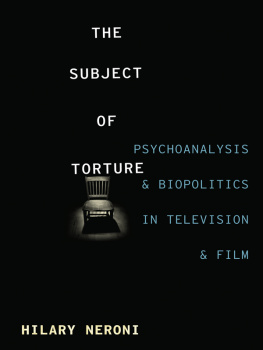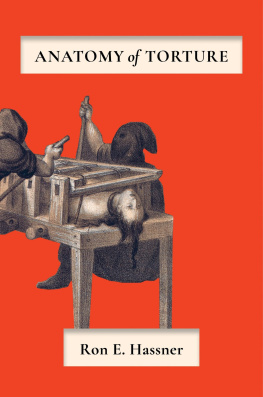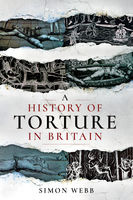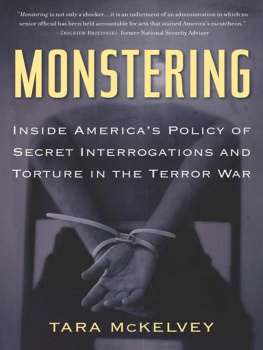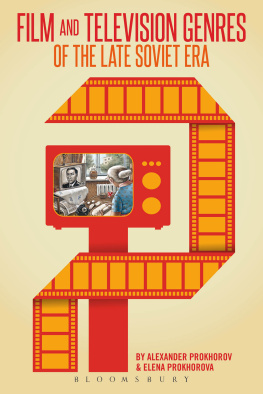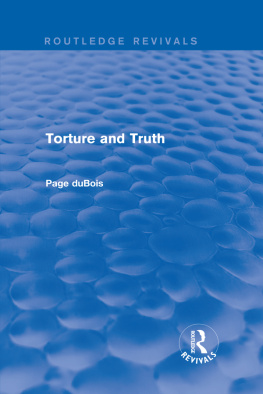The Subject of
TORTURE
The Subject of
TORTURE
PSYCHOANALYSIS
AND BIOPOLITICS
IN TELEVISION AND FILM
Hilary Neroni
Columbia University Press
New York
Columbia University Press
Publishers Since 1893
New York Chichester, West Sussex
cup.columbia.edu
Copyright 2015 Columbia University Press
All rights reserved
E-ISBN 978-0-231-53914-2
Library of Congress Cataloging-in-Publication Data
Neroni, Hilary, 1969
The subject of torture : psychoanalysis and biopolitics in Television and Film/Hilary Neroni.
pages cm
Includes bibliographical references and index.
ISBN 978-0-231-17070-3 (cloth: alk. paper)
ISBN 978-0-231-17071-0 (pbk.: alk paper)
ISBN 978-0-231-53914-2 (e-book)
1. Torture in motion pictures. 2. Torture on television. 3. Torture in mass media. 4. Psychoanalysis and motion pictures. 5. Psychoanalysis and television. 6. Motion picturesMoral and ethical aspects. 7. TelevisionMoral and ethical aspects. 8. Mass mediaMoral and ethical aspects. I. Title.
PN1995.9.T67N47 2015
791.43'6352dc23 2014034082
A Columbia University Press E-book.
CUP would be pleased to hear about your reading experience with this e-book at .
COVER DESIGN: Lisa Force.
COVER IMAGE: istockphoto
References to Web sites (URLs) were accurate at the time of writing. Neither the author nor Columbia University Press is responsible for URLs that may have expired or changed since the manuscript was prepared.
To Todd McGowan
CONTENTS
To begin with, I would like to thank Studies in Documentary where a version of was published as The Nonsensical Smile of the Torturer: Documentary Form and the Logic of Enjoyment. I am also indebted to Ethan Wattley and Tony Magistrale at the University of Vermont for their help in shaping the book.
Thanks to my students and colleagues in the Film and Television Studies Program at the University of Vermont, especially to my wonderful colleagues Deb Ellis, David Jenemann, Todd McGowan, Sarah Nilsen, and Hyon Joo Yoo. A special thank you to Frank and Sheila Manchel for their support and check-ins to see if Id finished and to Rashad Shabazz for sharing his work and ideas. To our theory reading groupJoseph Acquisto, Bea Bookchin, John Waldron, and Todd McGowan, and Hyon Joo Yooyour devotion to our discussions always buoyed me. And a special thanks to Bea for modeling just what a real intellectual looks like.
I am lucky and honored to have Emily Bernard, Jennifer Friedlander, Sarah Nilsen, and Hyon Joo Yoo as my closest friends and my excellent colleagues. Their individual strength, creativity, and passion inspire me every day. Thanks to Paul Eisenstein and Mac Davis for being friends whose intellectual integrity provides endless inspiration. Frances Restuccia invited me to talk about my ideas with her graduate class and their questions breathed new life into my own questions. I am also grateful to Frances for discussing Agamben with me and providing such careful observations about his ideas, which became important to my own. Thank you to Jean Wyatt for being such an important friend, role model, and supporter. I could not have gotten through this project without Sheila Kunkles friendship and her astute help at all stages of the manuscript. Many thanks to Jennifer Friedlander and Henry Krips for listening to more conference papers on representations of torture than anyone else. Their patience is as boundless as their much appreciated enthusiasm, and their conference on realism at Pomona in 2013 provided yet another arena in which I encountered ideas important to this book. Thanks to Luka Arsenjuk for staging the Cinema and Violence conference at the University of Maryland in 2013 and provoking many interesting conversations around violence and torture. David Denny and Justin Clemens have each been working on torture and violence in their own insightful ways and I was lucky enough to have their questions, challenges, and encouragement over the years. Thanks to Rick Boothby for his excellent reading and comments. Thanks to Ken Reinhard both for having me present these ideas in his graduate class and for his invaluable help in bringing this book into existence. I am also grateful to Slavoj iek and Joan Copjec for their inspiring work and their generous support.
Thank you to my family. My parents, Jane and Del Neroni, have taught me that passions and work are not separate. Im grateful to them for their love, support, and inspiration. To Nico Taranovsky and Sharon Preves for their kindness, wisdom, and humor. My mother-in-law, Sandi McGowan, seems to believe in me endlessly and was kind enough to provide many hours of babysitting our twin boys. Thanks as always to Diana Cataldi, Wyk McGowan, and Gina McGowan for their love and understanding. Id also like to thank my sons, Dashiell and Theo Neroni, for their love and exuberance. Ive been writing this book for half of their lives, and especially in the last couple years they have encouraged me with a compassion and understanding that always takes me aback. Finally, Id like to thank Todd McGowan, but he thinks complements are too clichd to be meaningful, so Ill just thank him for his always-at-hand provocations.
THE HIDDEN EXPOSED
In late April 2004, the shocking photographs from Abu Ghraib depicting American military personnel and their prisoners were made public. It is not by chance that the representations in these photographs brought the question of torture to the foreground. Representations of torture have been at the heart of the torture debate in recent years, and the outcome of this debate will undoubtedly revolve around what sort of representation becomes the accepted standard. Thus, a book on the theoretical implications of torture must be, I contend, at the same time a book on the media representation of torture. This is the contemporary battlefieldand it is the terrain of this book.
The images from Abu Ghraib revealed horrible scenes of abuse perpetrated by American soldiers who seem to be thoroughly enjoying themselves rather than reluctantly performing their duty. No official doctrine could quell the questions and intense emotion that these images provoked. One photograph, for example, depicts a stacked pyramid of naked Arab male bodies with United States Army Specialist Sabrina Harmon leaning close to their bodies, smiling, and giving a thumbs-up sign, while Specialist Charles Graner stands nearby smiling with his arms crossed. The men in the pyramid have green bags tied around their heads, and they are clearly holding onto each other while struggling not to fall. Tension in their entwined outstretched bodies indicates the pain of their positions. In frightening contrast to this painful, bizarre, and sexually charged pyramid of men, Harmon and Graners bodies, in military uniforms, seem relaxed, in control. Their smiles signify that they are enjoying themselves through the pain they are causing their prisoners. The contrast between their enjoyment and the prisoners evident humiliation in this military environment is so charged that it bursts out of the frame of the photograph.
Another photograph depicts a prisoner naked, chained to a bed, with arms outstretched and womens underwear on his head. His bulging muscles chained to the metal frame contrasts with the underwear, a clear signifier of enjoyment that the guards are having at his expense. Yet another photograph shows a line of naked prisoners, again with bags over their heads, with Specialist Lynndie England pointing at the men, who are being forced to masturbate. In this photograph, England smiles with a cigarette hanging out of the corner of her mouth. Englands enjoyment of the sexual abuse resonates at the front of the frame while the line of naked men recedes off into the dark barred hallway.

